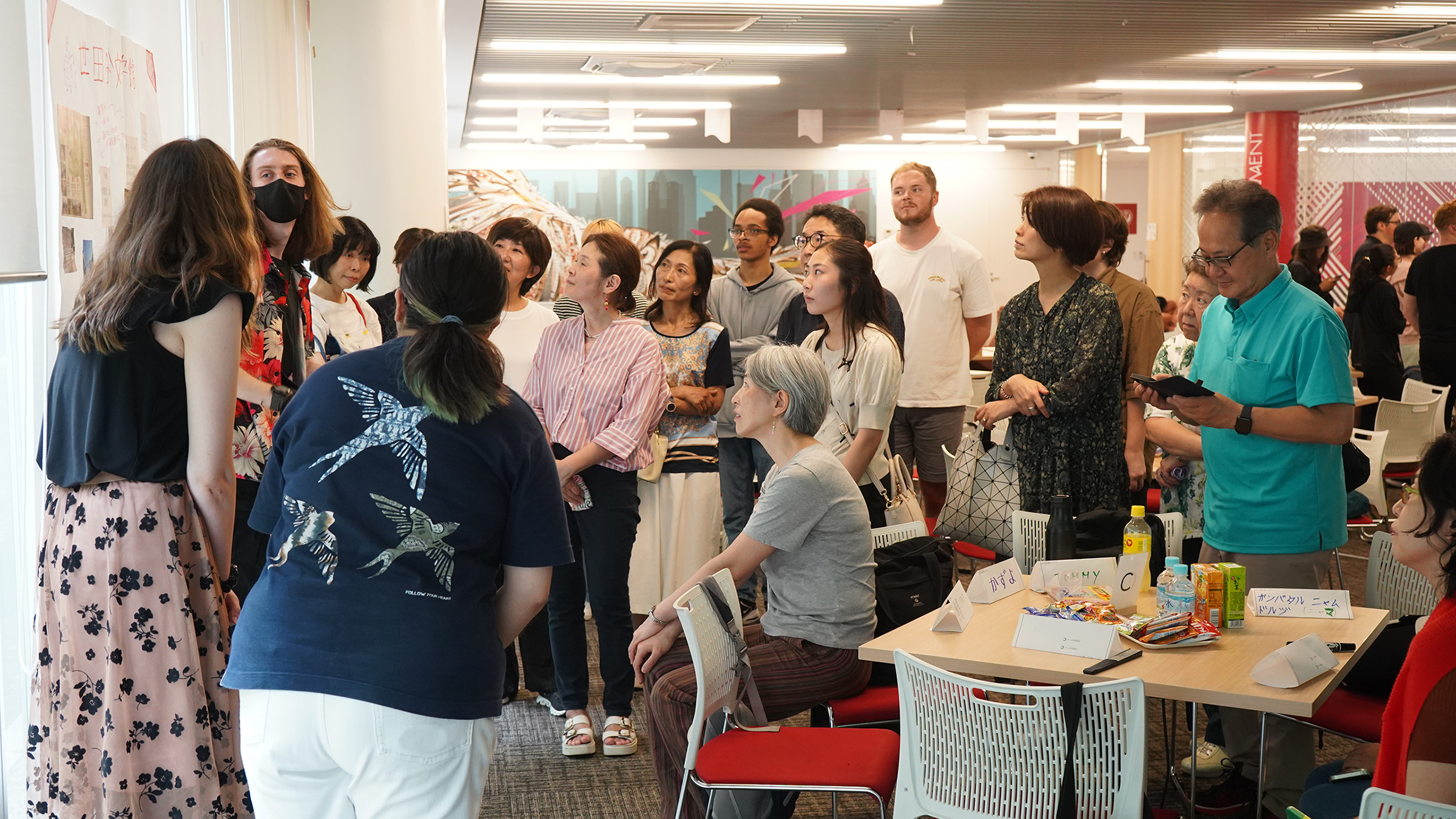Students deliver their presentation on Setagaya Literary Museum. Photo by Rie Nakajima (TUJ student)
Students taking Japanese language courses from the Japan campus of Temple University (TUJ), collaborated with a local community organization in Setagaya City in Tokyo, for an event aimed at fostering connection with neighboring residents. The event featured presentations and discussions, allowing TUJ students to enhance their language skills while providing participants the opportunity to experience the diverse and vibrant international atmosphere at TUJ.
Relocated to Setagaya in 2019, TUJ has been strengthening bonds with the community through a variety of activities involving students, faculty and administrative staff. This event, involving the faculty and students of the university’s Japanese language program, has been held regularly with the local organization, Crossing Setagaya, which has become more active since the pandemic subsided. The latest event took place on July 6, 2024, at TUJ’s Parliament student lounge, drawing about 30 participants from the neighboring area and 22 TUJ students. This was the second time this year following the one in March. Last year, this event was held four times, consistently attracting interest on each occasion.
“This event is becoming very popular among people in Setagaya,” said Kazuteru Mayuzumi, a manager of international affairs of Setagaya Arts Foundation. “We usually post the advertisement for the TUJ event on our website, inviting 30 people to the event and each time it gets filled very quickly. We get many new applicants as well as repeated attendees. We received very good feedback, saying they are satisfied after taking part in the event, meeting with students and experiencing the atmosphere of TUJ.”
For the most recent event, students formed three groups to visit and report on the three spots familiar to Setagaya locals, the Gotokuji temple, the Bajikoen park (the venue for equestrian-related events for the Tokyo Olympics in 1964 and 2021) and Setagaya Bungaku Kan (Setagaya Literary Museum). Each of the groups made posters to introduce the highlights of the areas. The participating locals were broken into three groups to listen to each presentation. All presentations were delivered in Japanese and participants asked many questions, inspired by the presentation with diverse and informative insights from TUJ students of various nationalities, such as the U.S., Mongolia, China and others.
“I believe many participants are already familiar with these places but there were still many questions,” Mayuzumi said. “The presentation drew interest because participants were inspired by the way students were observing these three places differently. Nowadays, people can do research on the Internet, but there was value because students actually went there, interviewed many people in Japanese and delivered their findings in Japanese.”
Students and participants later broke into several groups to engage more closely, taking part in a trivia quiz and discussion about Japanese culture.
Many participants expressed their satisfaction with the event as they were able to witness the hard work and serious attitude of the TUJ students. They also said it was a good opportunity to enjoy the atmosphere of the campus.
Katsuhiko Nagase, who attended the event and came to TUJ for the first time, enjoyed meeting students from many nationalities and sharing thoughts about Japan and their cultures. “I could tell that they are all serious and have a deep interest in Japan and that they are here to study with a strong will,” he said.
Setsuko Okazawa, who also attended the event for the first time, learned about the event through the Setagaya City newsletter. She belongs to a volunteer group that teaches Japanese language and culture to foreign students. Okazawa said she was surprised by how good TUJ students’ Japanese was. “Everyone was very enthusiastic about their presentations and I feel that they are very serious about learning Japanese. When I asked them what they do when they are not studying, they were very dedicated to their part-time work, which made a great impression on me.”
Two TUJ faculty members of the Japanese language program, Assistant Professor Asako Yamaguchi and Lecturer Chiho Okada, took key roles in guiding their students’ preparation for each event and fostering relationships with Crossing Setagaya.

Yamaguchi, who has been instrumental in developing the event since 2021, said that speaking with a wide range of age groups, especially with middle-aged and elderly Japanese natives, provides students with more opportunities to practice the language. “It’s an opportunity for students to step out of their comfort zone,” she said. “It’s a valuable experience for students who wish to find a job in Japan as it helps them connect with people in the community.”
TUJ students saw this event as a valuable chance to communicate with residents and improve their Japanese language skills. “It was a great opportunity to build confidence in speaking,” said Ethan Burke, a freshman at TUJ. He noted that the event was especially important for students in introductory-level classes. “Since it was a very open environment and everyone was very nice, it was a great opportunity to start building confidence.”
Other related stories
- Temple University, Japan Campus Expands in Tokyo, Adds New Location, Facilities to Accommodate Growing Student Body (August 5, 2024)
- TUJ Students Welcome Sangenjaya Community by Hosting Summer Matsuri Festival on July 1 (June 18, 2024)
- Unveiling TUJ Student Talent at Spring Art and Crafts Festival Welcomes Setagaya City Community on April 3 (March 28, 2024)

